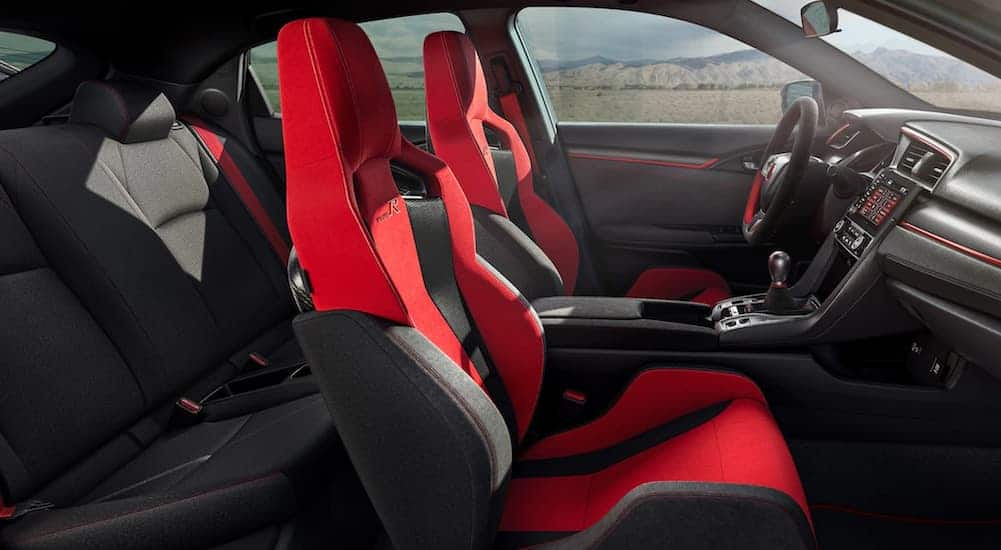The Honda Civic has long been one of the most popular compact cars on the market, renowned for both its sporty handling and its ease of modification. And for those preferring a more performance-oriented vehicle, the Honda Civic Si has been a long-time favorite. But until the last few years, American drivers have been unable to purchase the ultimate Civic––the Honda Civic Type R. First produced for the Japanese market in 1997, the Honda Civic Type R sported a stiffer chassis, serious weight reduction measures, and a more powerful engine. But while the Civic Type R soon migrated to the European market, it never managed to find its way to America until the release of the fourth-generation Civic Type R in 2017.
This might be explained by the fact that in many ways, the Honda Civic Type R is the antithesis of your typical American performance car. A lightweight, front-wheel drive hatchback with a small four-cylinder engine, the Civic Type R will never compete with a rear-wheel drive V8 pony car on the drag strip. However, put the Honda Civic Type R on the touge or a winding track, and it comes into its own. With an official 7:43 lap time on the famed Nurburgring Nordschleife, the current Honda Civic Type R has demonstrated its ability to not only beat the American V8 coupes but even expensive European sports cars such as the Porsche Cayman or the BMW M2.
What Makes a Civic a Type R?

Despite being branded as a Civic, the Honda Civic Type R actually shares very little with your average Civic or Civic Si. Indeed, the Civic Type R even has a separate manufacturer’s code, being referred to as the FK8 when the normal tenth-generation Civic hatch is the FK7. While the most obvious change to create the Honda Civic Type R is its 2.0L turbocharged engine delivering 306 horsepower and 295 lb-ft of torque, this is only the tip of the iceberg. To begin with, the body of the car itself has also been substantially enhanced with the extensive use of structural adhesive to improve rigidity. And while the exterior looks of the current Honda Civic Type R have been polarizing, to say the least, its aggressive aero package is fully functional. From the large rear wing and underbody front spoiler to the hood scoop and roof vortex generators, the Civic Type R was designed with performance in mind.
But perhaps the most important change for the Civic Type R will go entirely unnoticed by most people––the completely redesigned suspension. Not only has it received the usual heavier springs and thicker anti-sway bars found on most sportier models, but the Honda Civic Type R also possesses active dampers that will modulate suspension stiffness depending on which of three drive modes is selected. However, the largest change is the suspension geometry itself. Instead of the standard McPherson struts found on the other Honda Civic models, the Civic Type R makes use of a unique “dual-axis” front strut that mounts the wheels closer to the hub. The reason behind this change is to eliminate torque steer––a common downfall of high-power front-wheel drive cars. This is one of the key changes that makes the Honda Civic Type R a genuine performance vehicle rather than simply an economy car with an oversized engine. And as part of the 2020 model year, the suspension has been slightly modified to further improve steering feel.
Wheels, Brakes, and Weight
The wheels and brakes have also been seriously upgraded, giving the Honda Civic Type R its incredible grip and braking performance. Instead of the 18” wheels with 235/40 tires found on a normal Civic or Civic Si, the Civic Type R has 20” wheels with 245/30 tires. These wider tires and thinner sidewalls further contribute to its superior handling. For brakes, the Honda Civic Type R has four-piston Brembo calipers and, new for the 2020 model year, ventilated two-piece 13.8” front discs. Along with updated brake pads, this new disc design is intended to combat brake fade during performance driving. Combined with the light weight of the Civic Type R, these brakes are enough to bring it from 60 to 0 in just under 100 feet.
Despite all of these performance upgrades, the Honda Civic Type R remains incredibly light and weighs in at just 3,117 pounds. This is just 236 pounds more than the base Honda Civic Hatch, and 200 to 400 pounds lighter than competitors such as the Volkswagen Golf R or Subaru WRX STI. However, in truth, the Civic Type R has no real competitors. The other performance compact cars on the market are either significantly less powerful or rely on heavy all-wheel drive systems to tame their might. The Honda Civic Type R stands alone and unchallenged as not only the ultimate Honda, but the ultimate front-wheel drive racing machine.
An Increasingly Comfortable Interior
However, while the 2020 Honda Civic Type R is the best Civic Type R yet produced, it has begun straying from the original Civic Type R philosophy. Instead of being a stripped-down performance vehicle, it now offers all of the amenities and more of a standard top-trim Civic. This is particularly true for the 2020 model year, as Honda has finally succumbed and added the full Honda Sensing suite of advanced safety technologies to the Civic Type R. And while the addition of automatic emergency braking, lane keep assist, and adaptive cruise control will likely increase the safety of this vehicle, it is questionable just how many people actually wanted these technologies on their high-performance Honda. The 2020 Honda Civic Type R also introduces synthetic engine noise. Other arguably unnecessary luxuries include dual-zone automatic climate control with rear-seat vents and a twelve-speaker 540-watt premium sound system. The choice of an electronic parking brake rather than a manual one is also somewhat disappointing, and the 2020 model year also adds artificial engine noise for those disappointed by the sound of its small inline-four.
However, for those wishing for a return to a more racing-oriented Honda Civic Type R, Honda has announced that for the 2021 model year, it will be releasing a 600-model Limited Edition version. With forged aluminum wheels, reduced sound dampening, and elimination of the back row heating, this car will have 46 pounds of weight reduction. The European version of this Limited Edition will also be losing the infotainment system and air conditioning, but it appears Honda thought those changes were too drastic for the American market.
But even the standard 2020 Honda Civic Type R remains true to the original formula in many places. For instance, in contrast to many performance cars today, there are still no options for a sunroof, power seats, or an automatic transmission. And not all of the interior features on the Civic Type R are aimed at luxury either. In the instrument cluster, you will find the helpful inclusion of a lap timer and g-force meter, and seating consists of a pair of proper heavily-bolstered sports seats for the driver and front passenger. Finally, the typically crisp Honda manual shifter has been modified for the 2020 model year with a shorter throw.





